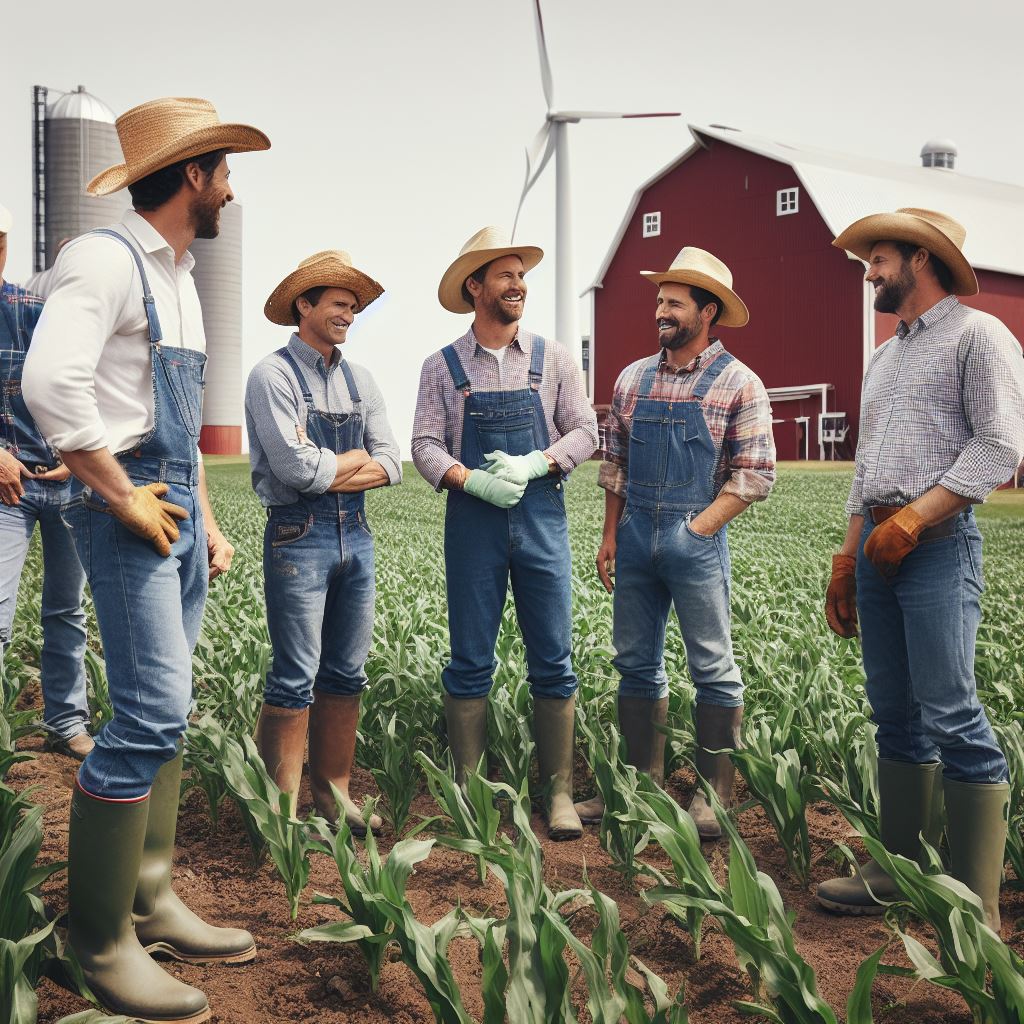Introduction
Land use policy refers to regulations and guidelines that govern the allocation and management of different types of land.
It is crucial to examine the conflict between farming and urbanization because of its significance.
Land use policy involves decisions made by governments to determine how land is used, such as for agriculture, residential areas, or commercial purposes.
Understanding the conflict between farming and urbanization is vital due to the increasing demand for land in urban areas.
This conflict affects food production and sustainable development.
Farming is essential for food production and rural economies, providing jobs and sustaining communities.
Urbanization, on the other hand, results in the expansion of cities and the conversion of agricultural land into residential or commercial areas.
The conflict arises when urbanization encroaches upon productive farmland, leading to its loss and potential negative impacts on food security.
Moreover, urbanization can result in pollution, habitat destruction, and the depletion of natural resources, affecting the overall sustainability of the ecosystem.
Striking a balance between farming and urbanization is crucial to ensure both food security and sustainable urban development.
To achieve this, land use policies need to consider the needs of both farming communities and urban areas, promoting efficient land management and maintaining agricultural productivity.
In short, examining the conflict between farming and urbanization is of utmost importance in land use policy.
Finding ways to address this conflict will ensure a sustainable future with adequate food production and well-planned urban areas.
Overview of Land Use Policy
Proper land use policy is essential to ensure the sustainable utilization of land resources.
It helps prevent unplanned urbanization, degradation of agricultural land, and loss of natural habitats.
Transform Your Agribusiness
Unlock your farm's potential with expert advice tailored to your needs. Get actionable steps that drive real results.
Get StartedBy understanding the definition, purpose, and objectives of land use policy, we can gain insights into how it contributes to balancing the needs of farming and urbanization.
Definition and purpose of land use policy
Land use policy refers to the guidelines and regulations set by governments to manage and control the utilization of land.
It aims to ensure that land resources are utilized efficiently and sustainably, taking into account various socio-economic and environmental factors.
The purpose of land use policy is to strike a balance between competing land uses, such as agriculture, housing, infrastructure development, and environmental conservation.
Key components and objectives of land use policy
Land use policy comprises several key components and objectives.
One of the primary components is zoning, which involves dividing land into different categories based on their designated use, such as agriculture, residential, commercial, or industrial.
Zoning helps regulate land use and prevent incompatible uses from coexisting.
Growth boundaries are another important component of land use policy.
They define the limits of urban development, ensuring that cities do not sprawl uncontrollably and encroach upon agricultural or natural areas.
Growth boundaries also help concentrate development within existing urban areas, promoting more efficient land use and reducing environmental impacts.
Environmental protection measures are integral to land use policy as well.
They include regulations and incentives aimed at preserving natural resources, protecting biodiversity, and mitigating pollution and other environmental threats.
By incorporating these measures, land use policy seeks to promote sustainable development practices and minimize the negative impacts of human activities on the environment.
Significance of land use planning in balancing competing land uses
Land use planning plays a crucial role in addressing the conflicts between farming and urbanization.
It allows for the systematic allocation of land for agricultural purposes, taking into account factors such as soil fertility, water availability, and proximity to markets.
This helps facilitate and support farming activities, ensuring food security and promoting rural livelihoods.
At the same time, land use planning helps control the expansion of urban areas, preventing the conversion of valuable agricultural land into housing or commercial developments.
By designating areas for residential, commercial, or industrial use, land use policy directs urban growth towards appropriate locations, reducing the potential conflicts with farming zones.
Additionally, land use planning can promote the integration of agriculture and urbanization through measures such as urban farming, community gardens, and green spaces within cities.
These initiatives not only provide local food production but also enhance the quality of urban environments and contribute to the overall sustainability of cities.
In fact, land use policy is a vital tool for managing land resources and balancing competing land uses in the context of farming and urbanization.
By defining the purpose and objectives of land use policy, understanding its key components, and recognizing its significance in land use planning, policymakers can develop effective strategies to ensure the sustainable development of both rural and urban areas.
Agricultural Land Use
Importance of farmland for food production
Farmland plays a crucial role in ensuring food production to meet the needs of a growing population.
It serves as the foundation for agriculture, which is essential for supplying food resources.
Showcase Your Farming Business
Publish your professional farming services profile on our blog for a one-time fee of $200 and reach a dedicated audience of farmers and agribusiness owners.
Publish Your ProfileBenefits of preserving agricultural land
Preserving agricultural land provides numerous benefits, including ensuring long-term food security,
promoting sustainable farming practices, and preserving biodiversity and ecosystem services.
Current challenges faced by farmers
- Competition for land from urban development poses a significant challenge for farmers trying to
maintain or expand their farming operations. - Pressures from industrial agriculture, characterized by large-scale mechanization and intensive
use of chemical inputs, can negatively impact traditional farming practices and small-scale farmers. - Regulatory policies, such as restrictions on water usage, pesticide use, and land zoning, can
impose additional burdens on farmers and limit their ability to sustain profitable farming practices.
Read: Farming Subsidies in Japan: 2024 Update
Urbanization and Its Impact
Definition and explanation of urbanization
Urbanization refers to the process of population growth and migration from rural areas to urban areas.
It involves the expansion of cities, towns, and other urban centers.
Factors contributing to urbanization
- Economic Opportunities: Urban areas offer better job prospects and higher income potential, attracting people from rural areas.
- Improved Infrastructure: Urban areas tend to have better facilities, such as healthcare, education, and transportation, making them desirable places to live.
- Social Factors: Urban areas often provide a wider range of social and cultural activities, leading to increased migration.
- Industrialization: The growth of industries in urban areas leads to the migration of individuals seeking employment in these sectors.
Effects of urbanization on land use
- Conversion of farmland into urban areas: As urbanization expands, more agricultural land is converted into residential, commercial, and industrial spaces.
- Loss of biodiversity and natural habitats: Urbanization results in the destruction of natural ecosystems and habitats, leading to a loss of biodiversity.
- Increased demand for resources and infrastructure: Urban areas require more resources like energy, water, and construction materials for housing and infrastructure development.
Urbanization has various impacts on land use patterns, with both positive and negative consequences.
While it can lead to economic development and improved living standards, it also poses challenges for sustainable land use and environmental conservation.
Conversion of farmland into urban areas
One of the major negative impacts of urbanization is the conversion of fertile farmland into urban areas.
As cities expand, fertile lands are lost, decreasing the availability of agricultural land.
This can lead to food security concerns and reliance on imported food.
Loss of biodiversity and natural habitats
Additionally, urbanization contributes to the loss of biodiversity and natural habitats.
As urban areas expand, natural ecosystems are destroyed, disrupting the balance of local flora and fauna.
This loss of biodiversity has long-term implications for ecosystem services and ecological stability.
Increased demand for resources and infrastructure
Another significant effect of urbanization is the increased demand for resources and infrastructure.
Rapid urbanization puts pressure on the availability of resources such as energy, water, and construction materials.
The infrastructure needed to support urban areas, including transportation networks and housing developments, requires substantial resource consumption and can lead to environmental degradation.
To mitigate the negative impacts of urbanization on land use, it is crucial to implement effective land use policies and urban planning strategies.
This includes promoting compact and efficient urban development, preserving agricultural land, and conserving natural habitats through green spaces and protected areas.
Furthermore, sustainable urban planning should prioritize the use of renewable resources, promote energy efficiency, and encourage the adoption of green building practices.
Investing in sustainable infrastructure and public transportation systems can also help reduce the demand for private vehicles, minimizing environmental impacts.
In general, urbanization, although contributing to economic growth and improved living conditions, has significant impacts on land use.
The conversion of farmland, loss of biodiversity, and increased resource demand are some of the challenges posed by urbanization.
It is essential to adopt sustainable land use policies and urban planning strategies to ensure a balance between urban development and environmental conservation.
Read: Agri-Taxation: Recent Global Reforms
Conflicts and Tensions
Conflicting interests between farmers and developers
As urbanization expands, farmers often face challenges and conflicts with developers who seek to convert agricultural land into urban areas.
Farmers want to preserve their land and maintain their livelihoods, while developers aim to profit from urban development.
Challenges in finding a balance between farming and urbanization
The increasing demand for urbanization poses a significant challenge in achieving a balance between agricultural practices and urban growth.
Efforts must be made to ensure that both sectors can coexist harmoniously and sustainably.
Examples of notable conflicts and their consequences
One notable conflict is the encroachment of urbanization on fertile farmland, leading to decreased agricultural productivity.
In many cases, valuable agricultural land is lost, thus contributing to food insecurity, diminishing biodiversity, and impacting local ecosystems.
Additionally, conflicts arise regarding the use of pesticides, fertilizers, and the pollution of water sources.
These conflicts may lead to damage to the environment and a strain on the relationship between farmers, urban dwellers, and policymakers.
Read: Food Safety Laws: Impact on Farmers

Land Use Policy Approaches
Zoning and land allocation strategies
Zoning and land allocation strategies play a crucial role in determining land use patterns.
By designating specific zones for farming and urbanization, conflicts can be minimized.
This approach allows for better planning and organization of land use activities.
Incentives for agricultural preservation
Providing incentives for farmers to preserve their land helps protect valuable agricultural areas.
Tax breaks, grants, and subsidies can encourage farmers to continue their operations.
Such measures promote the long-term sustainability of farming and discourage urban encroachment.
Sustainable land use practices and smart growth initiatives
Promoting mixed-use developments
Mixed-use developments incorporate both residential and commercial spaces in one area.
This approach reduces the need for sprawling suburban neighborhoods.
Showcase Your Farming Business
Publish your professional farming services profile on our blog for a one-time fee of $200 and reach a dedicated audience of farmers and agribusiness owners.
Publish Your ProfileBy allowing farms or community gardens within these developments, urban agriculture can thrive.
Implementing urban agriculture projects
Creating urban agriculture projects converts underutilized land into productive farm spaces.
These initiatives promote local food production, improving food security for urban populations.
Community gardens, rooftop farms, and vertical farming are examples of urban agriculture projects.
Encouraging agri-tourism and local food systems
Agri-tourism involves attracting visitors to farms and rural areas for recreational and educational purposes.
This benefits farmers financially and helps raise awareness about the importance of agriculture.
Promoting local food systems reduces dependence on imported food and supports local economies.
Read: NAFTA 2.0: Implications for North American Ag
Case Studies
Successful land use policy initiatives supporting farming
- Community Supported Agriculture (CSA) programs have emerged as successful models promoting sustainable farming.
- Land trusts have played a crucial role in preserving farmland by acquiring land and leasing it to farmers.
- Zoning regulations that prioritize agricultural land use over urban development have helped protect farming areas.
- Incentives such as tax breaks and subsidies have encouraged farmers to maintain their land for agricultural purposes.
- Collaborative efforts between farmers, government agencies, and non-profit organizations have resulted in successful farming communities.
Examples of challenges faced by urbanization projects
- Rapid urbanization leads to the conversion of farmland into residential or commercial areas, reducing agricultural productivity.
- Increased pollution from urban development affects soil quality, making it unsuitable for farming.
- High land prices and limited availability hinder farmers from acquiring or leasing land for farming.
- Changing consumer preferences and demand for imported foods impact the viability of local farming.
- Development projects often prioritize urban infrastructure over preserving agricultural land, leading to its loss.
Lessons learned and best practices from different regions
- The Netherlands has implemented innovative land use policies such as polder systems and urban agriculture to ensure food security.
- Japan has successfully integrated urban and agricultural areas through efficient land use planning and farming techniques.
- In the United States, the Farmland Preservation Program has been instrumental in conserving agricultural land and promoting farming.
- Australia has implemented land use planning strategies that prioritize sustainable farming practices and protect fertile land.
- Kenya has pioneered community land trusts to safeguard agricultural land and empower small-scale farmers.
Successful land use policies that support farming while managing urbanization are essential for sustainable development.
Through case studies, we have seen initiatives that promote farming and the challenges faced by urbanization projects.
Lessons learned from different regions provide valuable insights into best practices for effective land use policy.
To create a balance between farming and urbanization, collaboration and innovative solutions are crucial.
By prioritizing farming and implementing policies that preserve agricultural land, we can ensure food security and sustainable communities.
Conclusion
Amidst the sprawling urban frontier, farmlands stand resilient, embodying the struggle between agricultural tradition and urban expansion.
his pivotal element becomes the linchpin, harmonizing the coexistence of agriculture and urbanization.
Effective policies preserve biodiversity, secure food sources, and nurture ecosystems.
A resounding call echoes for policymakers to meticulously draft, implement, and adapt land use policies.
Simultaneously, farmers and communities bear the responsibility of embracing sustainable practices, cultivating a shared commitment to balanced cohabitation.
As the sun sets on the conflict between farming and urbanization, a collective dedication to prioritizing sustainable land use planning and policies ensures a brighter dawn for both our agrarian roots and urban aspirations.
It’s time to sow the seeds of harmony for a future where fields and cityscapes flourish side by side.




